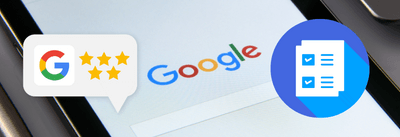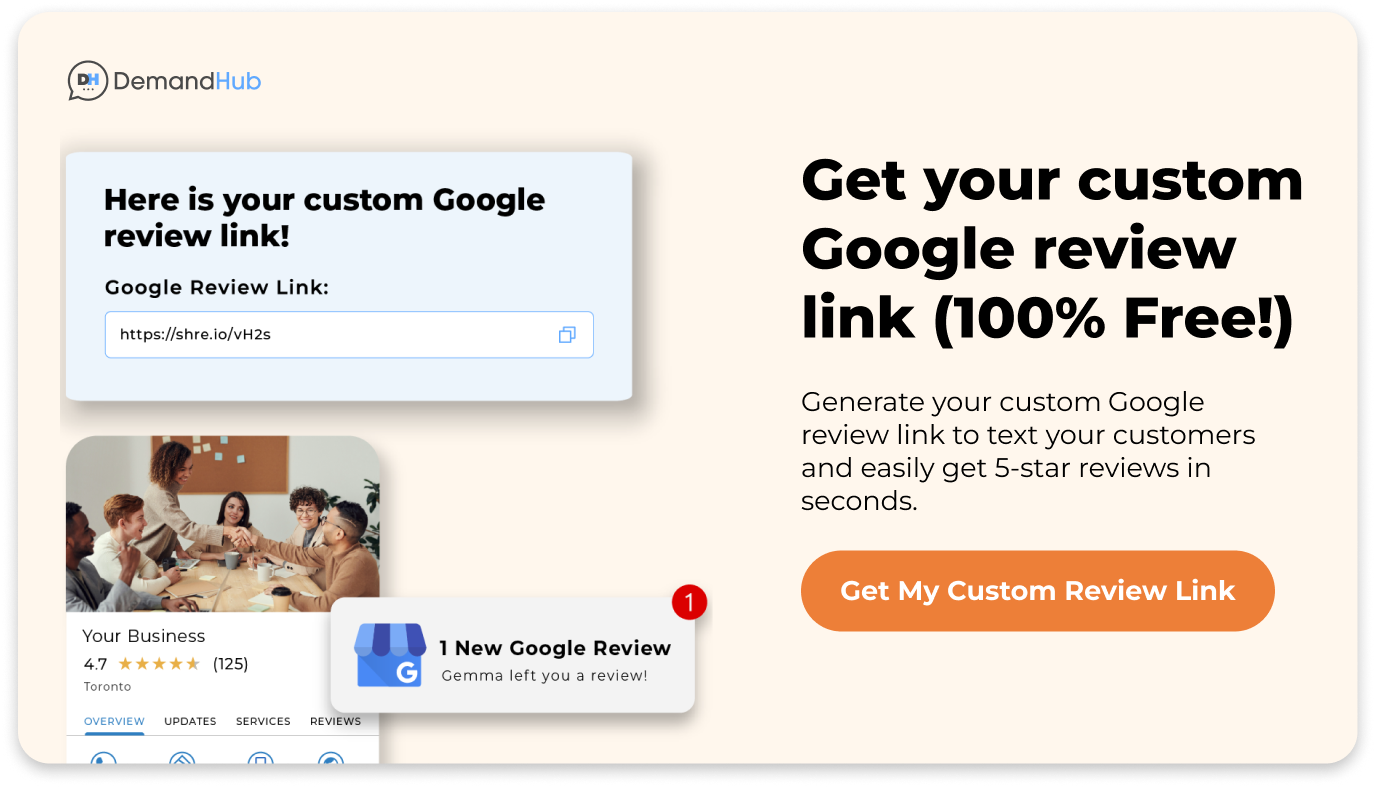Handling EHR appointment scheduling for your practice in 2024

Are you tired of managing the chaos that comes with scheduling appointments for your practice? Want to streamline the process and keep your patients happy?
In this article we’ll explore the world of EHR scheduling systems and how they can revolutionize your practice’s appointment management and help you keep up with the digital age.
We’ll discuss the benefits of using EHR appointment scheduling software and guide you through selecting the best medical scheduling software for your practice.
And, to help you find what system would work best for you we’ll shine a spotlight on integrating online appointment scheduling systems within your existing EHR system.
So, relax and allow us to lead the way on this journey to transform your practice’s appointment scheduling process into a seamless and hassle-free experience!
Table of Contents- What is EHR Scheduling?
- Different Types of EHR Software
- The Benefits of EHR Appointment Scheduling Software
- Features to Look for in an EHR Scheduling System
- How to Schedule Your Patients with the Help of EHR Software?
- 7 Best EHR Appointment Scheduling Software for 2024
- How to Choose the Right EHR Scheduling System for Your Practice?
- Conclusion
What is EHR Scheduling?
Electronic Health Record, or EHR scheduling, is a system that allows medical practices to set, modify, and cancel appointments electronically.
In any practice scheduling is a critical function that involves setting patient appointments, managing physician and staff schedules, coordinating room and equipment availability, and more. In the past, practices worked these tasks manually, using paper calendars or simple computer programs.
With the advent of EHR systems, these tasks are streamlined and efficient. EHR scheduling has now become a key component of modern healthcare management.
Different Types of EHR Software
EHR software has been a game-changer in the healthcare industry, making patient records digital and simplifying numerous administrative tasks. However, EHR software comes in various forms, each serving different needs. There are four types of EHR software you might encounter:
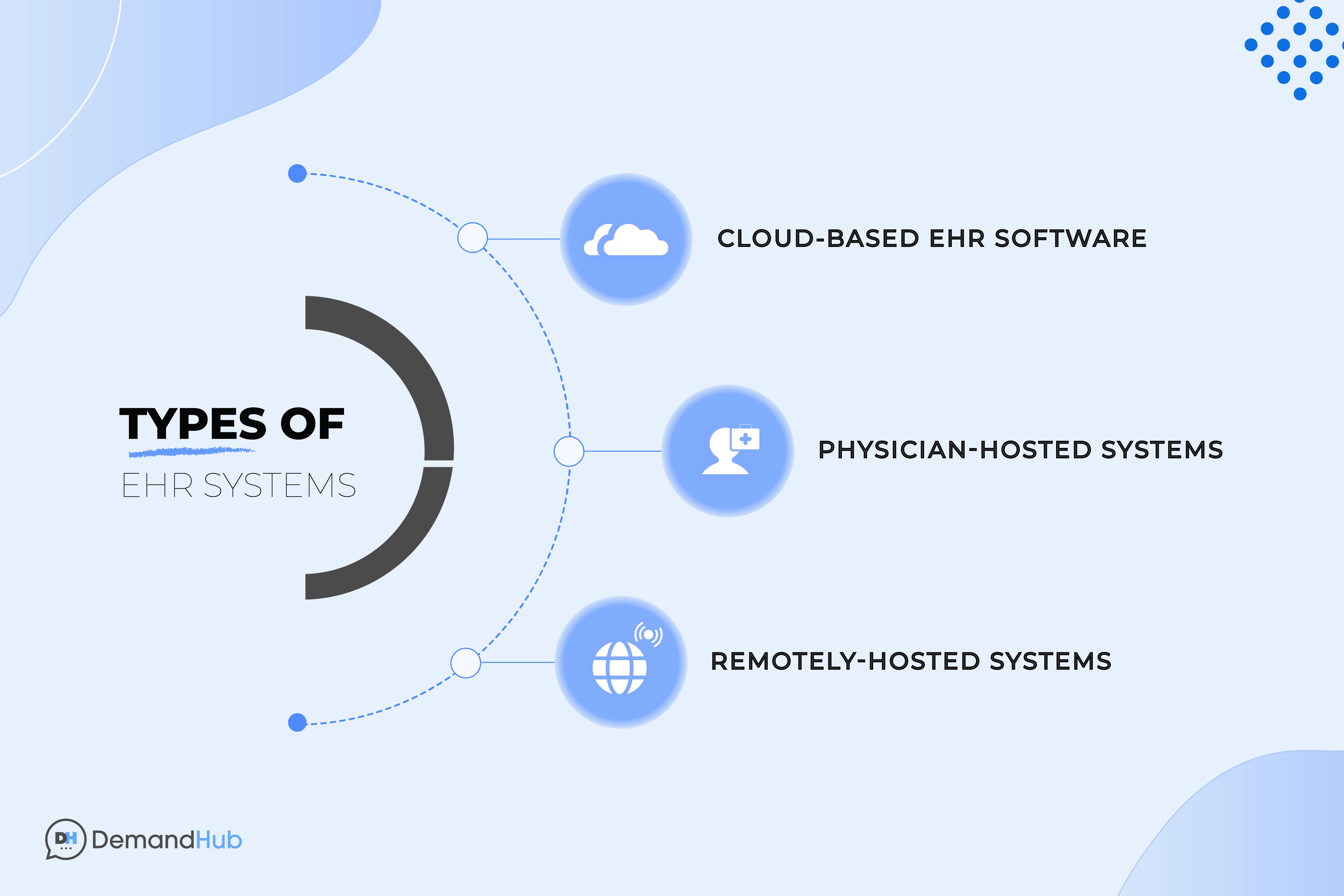
1. Cloud-Based EHR Software
Cloud-based EHR software stores and accesses patient data online via the web. This type of EHR software is a cost-effective solution for clinics as it eliminates the need for maintaining external servers, which third-party vendors handle. Patients can access their medical profiles anytime, although they cannot edit them.
2. Physician-Hosted EHR Systems
Physician-hosted EHR systems store patient data on the servers of physicians or organizations. This traditional model of EHR software can be expensive as it requires investment in hardware and software. The system must be installed physically on a computer or server at the location, and updates and patches require downtime.
3. Remotely-Hosted EHR Systems
Remotely-hosted EHR systems store patient data on the vendor’s servers, reducing the cost of managing hardware and software. This advanced technology is accessible via the Internet. It is ideal for medium-sized businesses looking to avoid upfront software purchase costs.
The vendor takes care of updates and upgrades, easing the burden on the clinic. This type of EHR system falls under three broad categories:
a. Subsidized
Ideal for small practices, the subsidized EHR model involves a third-party entity subsidizing the cost of the EHR server. However, the physician loses ownership of medical data, which can lead to ownership issues.
b. Dedicated
In this model, the physician enters into an agreement with the vendor and keeps the EHR at a specific location. Although doctors cannot control the data, they know where it is stored.
c. Cloud
Cloud-based EHR is one of the most popular systems worldwide. Here, patient data stays in a server managed by the vendor with 24/7 accessibility for physicians and medical staff. Rather than a straight-up payment, providers can make monthly or yearly payments.
Choosing the right EHR software for your facility is essential for maximum efficiency. Depending on your needs, you can look through these options and choose the right one to automate tedious and time-consuming processes. The optimal EHR will revolutionize your storage and help advance your practice.
The Benefits of EHR Appointment Scheduling Software
EHR appointment scheduling software offers numerous benefits to healthcare providers, staff, and patients. Here are some of the key advantages:
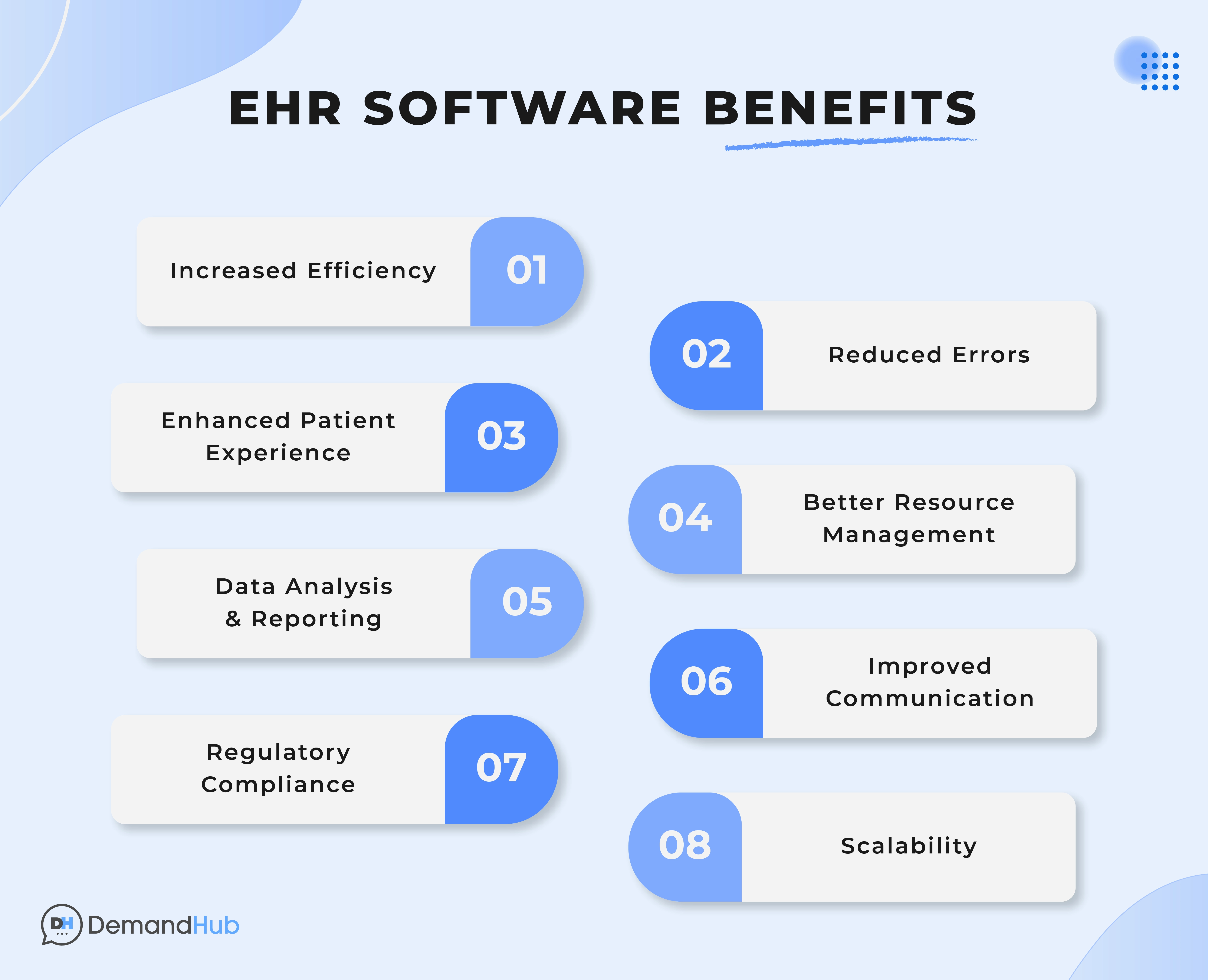
1. Increased Efficiency
EHR software automates scheduling appointments, reducing the time and effort needed to handle patient scheduling. This boosts productivity and efficiency in healthcare settings.
2. Reduced Errors
Manual scheduling can lead to errors such as double booking, missed appointments, or overlooked schedule conflicts. EHR scheduling software reduces these errors by automatically checking for conflicts and sending auto-reminders to patients and providers.
3. Enhanced Patient Experience
EHR software often includes features like online appointment booking, automated reminders, and easy rescheduling, which can significantly improve the patient experience. It can also reduce wait times by optimizing the appointment schedule.
4. Better Resource Management
EHR appointment scheduling can help manage patient appointments and the schedules of healthcare providers, rooms, and equipment. This can lead to better utilization of resources and cost savings.
5. Data Analysis and Reporting
EHR scheduling software can provide valuable data on appointment trends, cancellation rates, patient no-shows, and more. This data can help you pinpoint improvement areas and make educated decisions about resource allocation and scheduling policies.
6. Improved Communication
EHR software can facilitate better communication between patients and healthcare providers. For example, patients can receive automated reminders about upcoming appointments, and providers can easily view and manage their schedules.
7. Regulatory Compliance
EHR systems can help providers comply with regulations (HIPAA) related to patient data and privacy. They often include features designed to ensure the security and confidentiality of patient information.
8. Scalability
As a healthcare practice grows, EHR scheduling software can quickly scale to accommodate more patients, providers, and appointments. This renders it a versatile tool capable of adjusting to the evolving requirements of a healthcare organization.
Features to Look for in an EHR Scheduling System
As the healthcare industry continues evolving, practices are finding ways to streamline operations and improve patient care. One area that has witnessed significant expansion is using electronic health record (EHR) scheduling systems.
However, not all EHR scheduling systems are created equal. Following are some key features you must consider when selecting an EHR scheduling system for your practice:
1. Appointment Scheduling
The core functionality of any EHR scheduling system is the ability to schedule appointments. This feature lets you easily book appointments, reschedule or cancel existing ones, and view the day’s schedule at a glance. It also allows for easy navigation through future and past dates to view and manage appointments.
2. Patient Self-Scheduling
A patient self-scheduling feature allows patients to book their own appointments online. This can greatly increase patient convenience and reduce the administrative burden on your staff. Patients should be able to view available time slots, choose a suitable time, and book their appointment, all without needing to call or visit your office.
3. Automated Appointment Reminders
Missed appointments can throw a wrench in the works for healthcare practices. When patients don’t show up, it messes with the whole schedule. It can even impact other patients who could have used that slot. It’s a tricky issue, but luckily, there are ways to tackle it!
Automated appointment reminders can reduce no-shows by sending patients a reminder via email, or text message, a day or two before their appointment. This feature can also help improve patient satisfaction by ensuring they don’t forget their appointments.
4. Customizable Appointment Types and Durations
Every healthcare practice is unique, and so are its scheduling needs. Your EHR scheduling system should allow you to customize appointment types (e.g., initial consultation, follow-up visit, physical exam) and set default durations for each kind. This allows for more accurate scheduling and ensures providers have enough time for each appointment.
5. Waitlist Management
A waitlist management feature can help you fill cancellations and no-shows more efficiently. If a patient cancels, the system can automatically notify patients on the waitlist who can take the open slot. This can help maximize your appointment utilization and reduce wasted time.
6. Integration with Other EHR Systems
Your EHR patient scheduling should be able to integrate seamlessly with other EHR systems. This includes electronic medical records, payments, and patient communication tools.
Integrations allow smoother workflows, as information can be shared easily between systems. For instance, as soon as a new appointment is booked, the system can automatically update the patient’s medical record with these details.
When choosing an EHR scheduling system, it’s critical to consider these key features. By doing so, you can find an option that not only meets your practice’s specific requirements but can also grow and adapt to your practice.
How to Schedule Your Patients with the Help of EHR Software?
Scheduling patients can be a breeze when you’ve got the right EHR software at your fingertips. Here’s a step-by-step guide to booking your patients with the help of EHR software:
Step 1: Get to Know Your Software
First things first, you’ve got to get familiar with your EHR software. Each system is a little different, but they all have a similar goal: to make your life easier. Spend time exploring the features, and don’t be afraid to click around and see what’s what.
Step 2: Set Up Your Schedule
Now, it’s time to set up your schedule. Most EHR systems let you customize your working hours, appointment types such as follow-up visits or new patient consultations, and even the length of appointments.
So, whether you’ve got a 15-minute check-up or a 1-hour consultation, you can make sure your schedule reflects that. Once you have set up your appointment schedule, you can start scheduling patients using the EHR software.
The patient will receive an electronic calendar invite with the appointment details. This can include the appointment’s date and time, the practice’s location, and any other relevant information.
Step 3: Patient Self-Scheduling (If Available)
If your EHR software offers patient self-scheduling, that’s a huge bonus. It means your patients can book their appointments online, saving everyone time. Make sure this feature is set up and working smoothly. And don’t forget to let your patients know they can use it!
Should patients need to reschedule or cancel their appointment, they can use the EHR software to make these changes. They can do this via a patient portal, which grants patients access to their medical records and facilitates communication with their healthcare provider.
Using the EHR software to manage appointments gives patients more control over their healthcare. They can easily modify their schedule as needed. And practitioners can view their plans online through the same EHR software.
Step 4: Booking Appointments
When booking appointments, your EHR software is your best friend. Just select the patient, choose an available time slot, and voila! The appointment is booked. And the best part? The system automatically avoids double-booking and helps manage schedule conflicts.
Step 5: Automated Reminders
Nobody likes no-shows, right? Well, your EHR software can help with that too. Most systems can send automated reminders to your patients via email or text. It’s a friendly nudge to make sure they remember their appointment.
Step 6: Managing Changes
Sometimes, appointments need to be rescheduled or canceled. No problem! Your EHR software makes it easy to make changes and keep everything up-to-date.
Step 7: Integrate with Other Systems
Finally, remember that your EHR software can often integrate with other systems. That means when you book a new appointment, other parts of the system, like billings, or patient records, get updated too. It’s all connected, making your job a whole lot easier.
Providers can view their schedules online through the EHR software after booking appointments. This allows them to see their upcoming meetings and any changes or cancellations. By accessing their schedules online, providers can manage their time more effectively and ensure they are ready for each appointment.
So there you have it! Scheduling patients with EHR software is a simple and efficient way to manage appointments and communicate with patients. EHR software saves healthcare practitioners time, reduces errors, and provides better patient care.
7 Best EHR Appointment Scheduling Software for 2024
Here are some of the best EHR appointment scheduling systems for healthcare practices in 2024:
- CareCloud
- Dr. Chrono
- Cerner
- Athenahealth
- eClinicalWorks
- NextGen Healthcare
- Greenway Health
DemandHub
While DemandHub may not be a traditional EHR platform, it simplifies the process of online bookings and appointment requests for patients by leveraging text messaging technology. This feature enhances the convenience and accessibility of scheduling healthcare appointments.
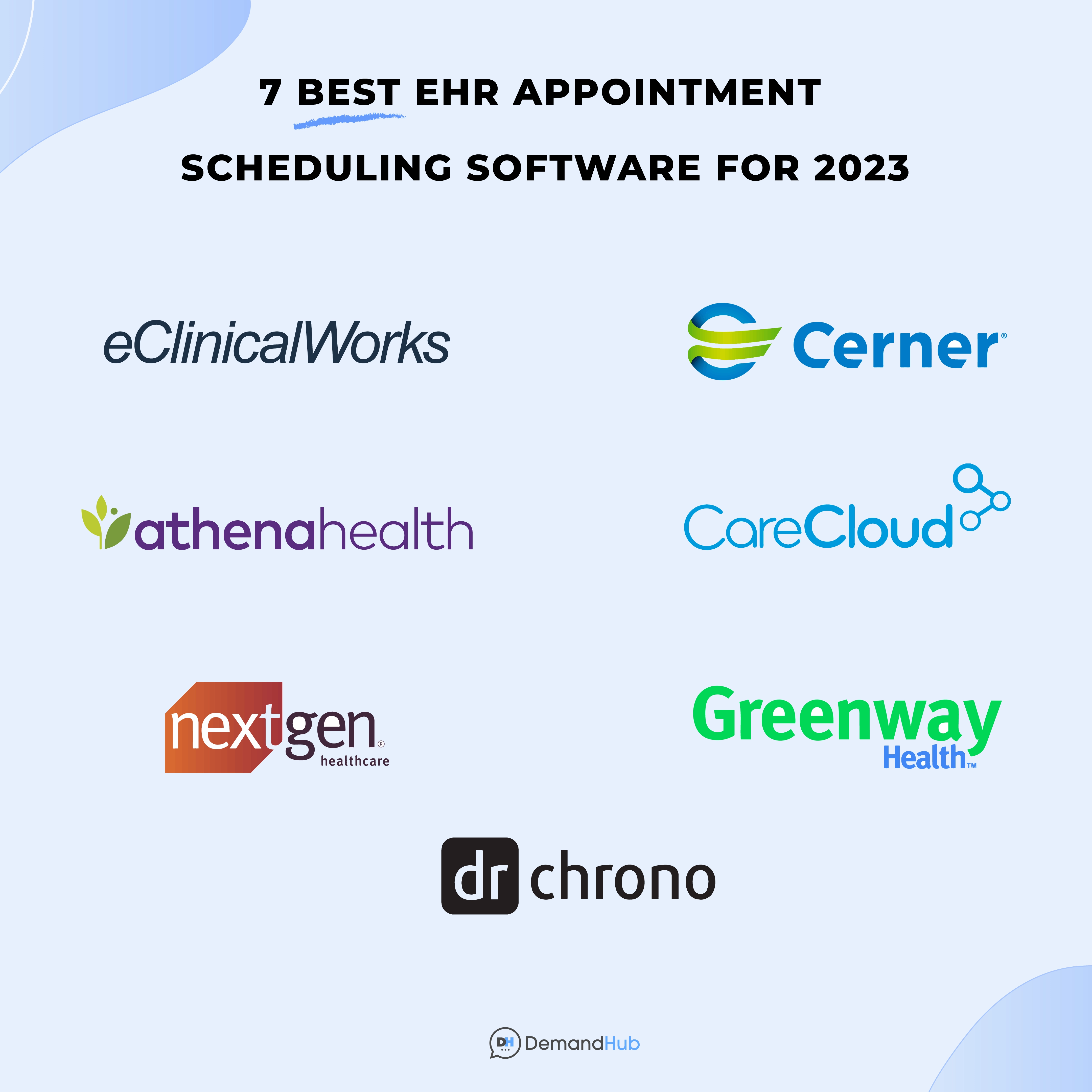
How to Choose the Right EHR Scheduling System for Your Practice?
Choosing the right EHR scheduling system for your practice is a big decision. It’s not just about picking the one with the most bells and whistles. It’s about finding the system that fits your practice like a glove.
Here’s what you should consider:
Cost
Let’s face it, budget matters. EHR systems come with different price tags, so pick one that fits your budget. But remember, the cost isn’t just about the upfront price. Consider the long-term value, too.
Will the system help you save time, reduce errors, and improve patient satisfaction? If so, it could be worth an extra investment.
Ease of Use
You don’t want to spend hours wrestling with a complicated system. Look for an EHR scheduling system that’s user-friendly and intuitive. You, your staff, and your patients (if you’re offering self-scheduling) should be able to navigate it easily.
Customizability
Every practice is unique, so a one-size-fits-all solution just won’t cut it. You’ll want an EHR system that lets you customize appointment types, durations, reminders, and more. The more you customize the system to your practice, the better it will serve you.
Practice Size
Are you a small practice with a single provider or a large clinic with multiple providers and locations? The size and complexity of your clinic will influence the kind of EHR scheduling system you need.
Some EHR software is designed for small practices, while others can handle larger, multi-location operations.
Features list
Think about the features that are significant to you. Do you want patient self-scheduling? Automated reminders? Waitlist management? Integration with other EHR systems? Make a checklist of your must-have features and use it to guide your decision.
Customer Support
Even the best EHR scheduling platform can have hiccups. That’s why choosing an EHR scheduling software with excellent customer support is crucial. Look for a company that offers timely, helpful service when needed. Check out reviews or ask other users about their experiences with the company’s customer support.
Conclusion
Navigating the world of EHR appointment scheduling is all about harnessing technology and finding the perfect tools to make your practice run smoothly.
It could be a traditional EHR platform or innovative solutions like DemandHub, which uses text messaging for super easy online bookings. The aim is simple - boost efficiency and improve your patients’ lives.
You can revamp your scheduling process by getting to grips with the various types of EHR software and pinpointing the features that fit your practice like a glove.This lets you zero in on what you do best - delivering top-notch patient care.
The future of healthcare is digital. And with the right EHR tools in your arsenal, your practice can be at the forefront of this exciting new era.

